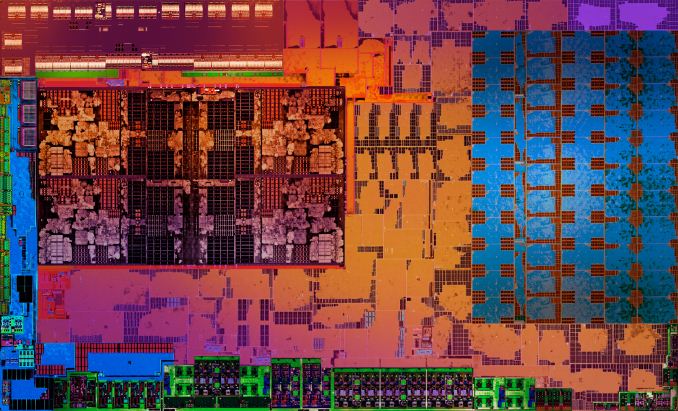CPU Design Guru Jim Keller Joins Intel; Completes CPU Grand Tour
by Ryan Smith on April 26, 2018 1:15 PM EST- Posted in
- CPUs
- Intel
- SoCs
- Jim Keller

For long-time AnandTech readers, Jim Keller is a name many are familiar with. The prolific microarchitectural engineer has been involved in a number of high-profile CPU & SoC projects over the years, including AMD’s K8 and Zen CPUs and Apple’s early A-series SoCs. Now after a stint over as Tesla for the past couple of years, Intel has announced that they have hired Keller to lead their silicon engineering efforts.
After rumors on the matter overnight, in a press release that has gone out this morning, Intel confirmed that they have hired Jim Keller as a Senior Vice President. There, Keller will be heading up the 800lb gorilla’s silicon engineering group, with an emphasis on SoC development and integration. Beyond this, Intel’s press release is somewhat cryptic – especially as they tend not to be very forward about future processor developments. But it’s interesting to note that in a prepared statement included with the press release, Dr. Murthy Renduchintala – Intel’s Chief Engineering Officer – said that the company has “embarked on exciting initiatives to fundamentally change the way we build the silicon as we enter the world of heterogeneous process and architectures,” which may been seen as a hint of Intel’s future direction.
What is known for sure is that for most of the last decade, Keller’s engineering focus has been on low-power hardware. This includes not only his most recent stint at Tesla working on low voltage hardware, but also his time at Apple and PA Semiconductor developing Apple’s mobile SoCs, and even AMD’s Zen architecture is arguably a case of creating an efficient, low-power architecture that can also scale up to server CPU needs. So Keller’s experience would mesh well with any future development plans Intel has for developing low-power/high-efficiency hardware. Especially as even if Intel gets its fab development program fully back on track, there’s little reason to believe they’re going to be able to duplicate the manufacturing-derived performance gains they’ve reaped over the past decade.
As for any specific impact Keller might have on Intel’s efforts, that is a curiosity that remains to be seen. Keller’s credentials are second to none – he’s overseen a number of pivotal products – but it bears mentioning that modern processor engineering teams are massive groups working on development cycles that span nearly half a decade. A single rock star engineer may or may not be able to greatly influence an architecture, but at the same time I have to imagine that Intel has tapped Keller more for his leadership experience at this point. Especially as a company the size of Intel already has a number of good engineers at their disposal, and unlike Keller’s second run at AMD, the company isn’t recovering from a period of underfunding or trying to catch up to a market leader. In other words, I don’t expect that Intel is planning on a moment of Zen for Keller and his team.

One of Jim Keller's Many Children: AMD's Raven Ridge APU
Though with his shift to Intel, it’s interesting to note that Jim Keller has completed a de facto grand tour of the high performance consumer CPU world. In the last decade he’s worked for Apple, AMD, and now Intel, who are the three firms making the kind of modern ultra-wide high IPC CPU cores that we see topping our performance charts. Suffice it to say, there are very high-profile engineers of this caliber that these kind of companies will so openly court and/or attempt to pull away from the competition.
For those keeping count, this also marks the second high-profile architect from AMD to end up at Intel in the last 6 months. Towards the end of last year Intel picked up Raja Koduri to serve as their chief architect leading up their discrete GPU development efforts, and now Jim Keller is joining in a similar capacity (and identical SVP title) for Intel’s silicon engineering. Coincidentally, both Kodrui and Keller also worked at Apple for a time before moving to AMD, so while they haven’t been on identical paths – or even working on the same products – Keller’s move to Intel isn’t wholly surprising considering the two never seem to be apart for too long. So it will be exciting to see what Intel is doing with their engineering acquisitions over the coming years.
Source: Intel










70 Comments
View All Comments
FunBunny2 - Friday, April 27, 2018 - link
he's not entirely high. google the ti-990 and read up the architecture.ilt24 - Thursday, April 26, 2018 - link
RedGreenBlue, I'm sure AMD tried to keep him, but I think Keller felt he completed the job they hired for and wanted to try something different.We are talking about a guy that starting working on VAX and then Alpha at DEC, jumped to AMD to work on the K8, left AMD to go work on some MIPS processor, then to PA semi to work on ARM, Apple bought them and he worked on a couple of Apple SOC's before going back to AMD to do Zen, jumped to Tesla and now to Intel.
tipoo - Thursday, April 26, 2018 - link
Looking at his history, I dont' think it's about AMD. He goes where he goes until his work is done, then moves on when a core/project is in good shape.jjj - Thursday, April 26, 2018 - link
From the start he was only gonna stay at AMD for 3 years, he did his part and moved on, just like now at Tesla. He does his job and moves to the next project, instead of babysitting it for 5 more boring years.Cooe - Thursday, April 26, 2018 - link
When you are literally the best person in the world at what you do, you pick and choose who you are going to work for and what you are going to work on, not any company. Not only did circa-2015 near bankruptcy AMD not have the kind of bankroll to afford keeping him on long-term, but with the Zen design finished, and Zen 2 laid out, there simply wasn't enough interesting stuff going on to keep him there anymore. Kind of sad he's now working for the company that pulled such egregiously illegal anti-competitive practices to torpedo the best designs he ever worked on though (K7 & K8), but I can definitely understand the allure. Intel's arch efforts have hit a massive brick wall so just like AMD they are gonna give him completely free reign with all the keys to the castle, but unlike AMD, has the bankroll on tap to let Jim do pretty much whatever the hell he wants, for as long as he wants. Zen otoh was more of a favor to save the company that launched him than a long term destination, though honestly with Jim's track record and penchant for "big paradigm shifting projects" I wouldn't be surprised at all of this Intel stint also only lasts a few years before he picks up shop for somewhere else yet again.FunBunny2 - Thursday, April 26, 2018 - link
"Intel's arch efforts have hit a massive brick wall"it will be really interesting to see whether the maths will support any more significant increase in circuit performance. that's separate from migrating lots o off-chip logic on-chip. at some point the maths dictate the "best " instruction set (micro or otherwise) for a given problem space.
Samus - Thursday, April 26, 2018 - link
Jim Keller and Hector Ruiz saved AMD. Without either of them, AMD would have probably filed for bankruptcy at some point. Two engineers at the top of their game.Kevin G - Friday, April 27, 2018 - link
Jim didn't get everything he wanted at AMD though. Where is the K12 ARM core?patrickjp93 - Saturday, April 28, 2018 - link
Put on hold until the world shows some real demand for ARM-based servers. Even Qualcomm Centriq isn't exactly turning heads.DiamondPugs - Sunday, December 23, 2018 - link
AMD didn't let Jim Keller go. He left because he didn't want to work for AMD anymore. He is a very interesting person, the kind you cannot buy simply with money. Micro-architectures are his passion, he works for joy, and he usually looks for a big challenge. He joined AMD again because they were looking to create a new architecture from scratch capable of competing with Intel, and after it was done there was nothing of interest for him in the company. He simply left to pursue a similar challenge somewhere else. Later he joined Tesla and helped them with their self-driving car processors since that was a big challenge. Intel is now looking to create a new architecture and that got his attention.